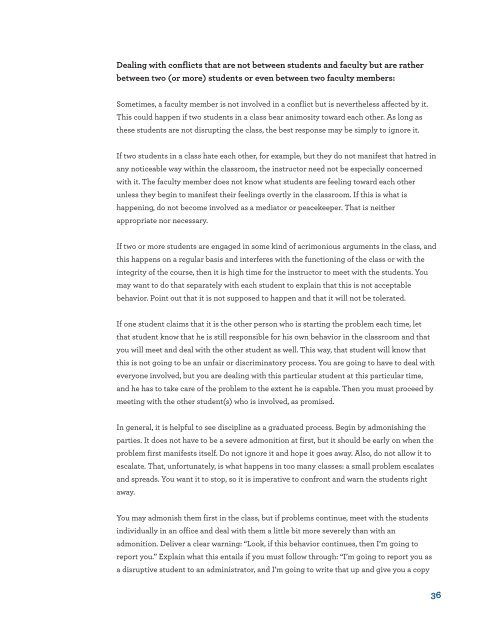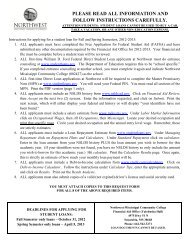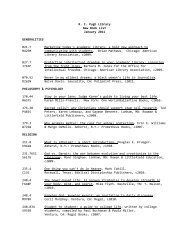Coping with Seven Disruptive Personality Types in the Classroom
Coping with Seven Disruptive Personality Types in the Classroom
Coping with Seven Disruptive Personality Types in the Classroom
Create successful ePaper yourself
Turn your PDF publications into a flip-book with our unique Google optimized e-Paper software.
Deal<strong>in</strong>g <strong>with</strong> conflicts that are not between students and faculty but are ra<strong>the</strong>rbetween two (or more) students or even between two faculty members:Sometimes, a faculty member is not <strong>in</strong>volved <strong>in</strong> a conflict but is never<strong>the</strong>less affected by it.This could happen if two students <strong>in</strong> a class bear animosity toward each o<strong>the</strong>r. As long as<strong>the</strong>se students are not disrupt<strong>in</strong>g <strong>the</strong> class, <strong>the</strong> best response may be simply to ignore it.If two students <strong>in</strong> a class hate each o<strong>the</strong>r, for example, but <strong>the</strong>y do not manifest that hatred <strong>in</strong>any noticeable way <strong>with</strong><strong>in</strong> <strong>the</strong> classroom, <strong>the</strong> <strong>in</strong>structor need not be especially concerned<strong>with</strong> it. The faculty member does not know what students are feel<strong>in</strong>g toward each o<strong>the</strong>runless <strong>the</strong>y beg<strong>in</strong> to manifest <strong>the</strong>ir feel<strong>in</strong>gs overtly <strong>in</strong> <strong>the</strong> classroom. If this is what ishappen<strong>in</strong>g, do not become <strong>in</strong>volved as a mediator or peacekeeper. That is nei<strong>the</strong>rappropriate nor necessary.If two or more students are engaged <strong>in</strong> some k<strong>in</strong>d of acrimonious arguments <strong>in</strong> <strong>the</strong> class, andthis happens on a regular basis and <strong>in</strong>terferes <strong>with</strong> <strong>the</strong> function<strong>in</strong>g of <strong>the</strong> class or <strong>with</strong> <strong>the</strong><strong>in</strong>tegrity of <strong>the</strong> course, <strong>the</strong>n it is high time for <strong>the</strong> <strong>in</strong>structor to meet <strong>with</strong> <strong>the</strong> students. Youmay want to do that separately <strong>with</strong> each student to expla<strong>in</strong> that this is not acceptablebehavior. Po<strong>in</strong>t out that it is not supposed to happen and that it will not be tolerated.If one student claims that it is <strong>the</strong> o<strong>the</strong>r person who is start<strong>in</strong>g <strong>the</strong> problem each time, letthat student know that he is still responsible for his own behavior <strong>in</strong> <strong>the</strong> classroom and thatyou will meet and deal <strong>with</strong> <strong>the</strong> o<strong>the</strong>r student as well. This way, that student will know thatthis is not go<strong>in</strong>g to be an unfair or discrim<strong>in</strong>atory process. You are go<strong>in</strong>g to have to deal <strong>with</strong>everyone <strong>in</strong>volved, but you are deal<strong>in</strong>g <strong>with</strong> this particular student at this particular time,and he has to take care of <strong>the</strong> problem to <strong>the</strong> extent he is capable. Then you must proceed bymeet<strong>in</strong>g <strong>with</strong> <strong>the</strong> o<strong>the</strong>r student(s) who is <strong>in</strong>volved, as promised.In general, it is helpful to see discipl<strong>in</strong>e as a graduated process. Beg<strong>in</strong> by admonish<strong>in</strong>g <strong>the</strong>parties. It does not have to be a severe admonition at first, but it should be early on when <strong>the</strong>problem first manifests itself. Do not ignore it and hope it goes away. Also, do not allow it toescalate. That, unfortunately, is what happens <strong>in</strong> too many classes: a small problem escalatesand spreads. You want it to stop, so it is imperative to confront and warn <strong>the</strong> students rightaway.You may admonish <strong>the</strong>m first <strong>in</strong> <strong>the</strong> class, but if problems cont<strong>in</strong>ue, meet <strong>with</strong> <strong>the</strong> students<strong>in</strong>dividually <strong>in</strong> an office and deal <strong>with</strong> <strong>the</strong>m a little bit more severely than <strong>with</strong> anadmonition. Deliver a clear warn<strong>in</strong>g: “Look, if this behavior cont<strong>in</strong>ues, <strong>the</strong>n I’m go<strong>in</strong>g toreport you.” Expla<strong>in</strong> what this entails if you must follow through: “I’m go<strong>in</strong>g to report you asa disruptive student to an adm<strong>in</strong>istrator, and I’m go<strong>in</strong>g to write that up and give you a copy36











![Pro-Dental Hygiene [Major Code T34] - Northwest Mississippi ...](https://img.yumpu.com/35524032/1/190x149/pro-dental-hygiene-major-code-t34-northwest-mississippi-.jpg?quality=85)




